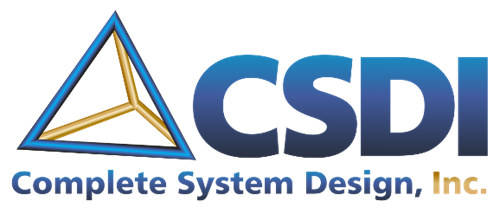75 S. Main Street 7-298
Concord
NH 03301
Office: 603-369-4499
Email: info@csdi.com
![]()
Four vertices, six cords, four surfaces. The tetrahedron is the simplest three dimensional object in nature. Take away a single point, it becomes a two-dimensional object. The tetrahedron has tremendous structural integrity. Force applied to any vertex is distributed to the other vertices, increasing its strength. This pattern is found repeatedly in nature, notably in the fields of engineering, chemistry, and biology.
Finally, we give a node to R. Buckminster Fuller who saw the application of this pattern in architecture and popularized the geodesic dome. Fuller was a brilliant mind and dedicated humanitarian who, like the tetrahedron, inspires our company and our values.
There is so much discussion about design, the term is no longer concise. The word is essential to us. It is our name, so we have adopted this practical definition:
This definition is derived from an excellent article by Todd Olsen, entitled "So, what is design anyway".
Buckminster Fuller coined the term "pattern integrity" to describe patterns that retain their characteristics regardless of the medium in which the pattern is observed. The concepts of reusability and encapsulation are fundamental to software design. We use the same design principals to integrate cloud services and create organizational processes.
Encapsulation is an important design concept that informs all of our work. As technology grows, there are more parts. Central servers have been replaced by cloud services. Cloud services frequently rely on supporting services. Access to the aggregate system needs to be limited to specific classes of users and the entire environment must be protected from malicious intent.
Our purpose is to simplify cloud systems for our customers through the implementation of excellent design.
The customer must know the input required by the system in order to receive the desired output. That interface is all the customer should need to know. Behind the interface are the many complex tasks and processes needed to create the required output. The interface must be hardened to prevent malicious attack and unauthorized access.
The number of available cloud packages and services is vast and that scope invites applications to be more complex. Our tasks is to integrate those services in a way that removes that complexity from client view.
Utility computing is a another term that has been in wide use for years. In essence, it is the concept that computing should be a utility, like water or electricity, that is available at the turn of a faucet or flick of a switch. Initially, utility computing applied to virtual machines that could be allocated as needed then released when no longer required.
While a significant improvement over on-premises infrastructure, virtual machines do not have enough utility. Water and electricity are delivered in a form that has immediate application. The end user can plug in a toaster or pour a glass of water and consume the output with no technical assistance. Software as a Service (SaaS) is a more utilitarian paradigm.
Software as a Service (SaaS) cloud services approach a more rigorous definition of utility computing.
CSDI strives to realize the promise of utility computing by designing comprehensive environments that meet customer needs.
Learn more about the processes we use to ensure the structural integrity of our systems.
In order to change an existing paradigm you do not struggle to try and change the problematic model. You create a new model and make the old one obsolete.
R. Buckminster Fuller
